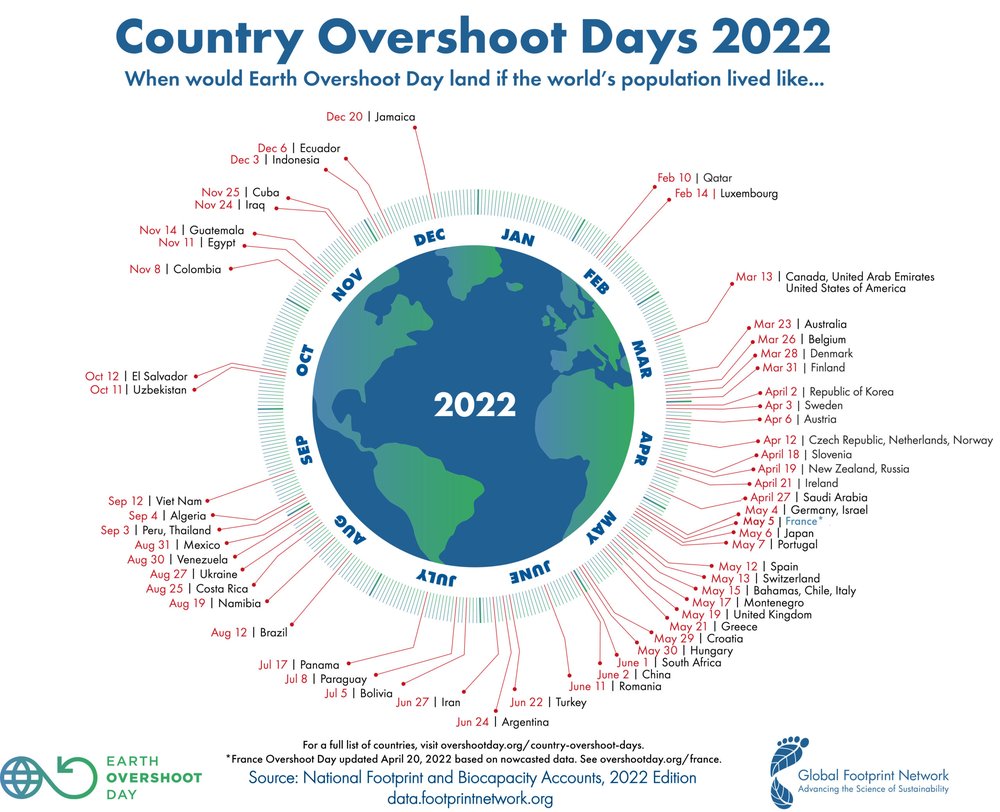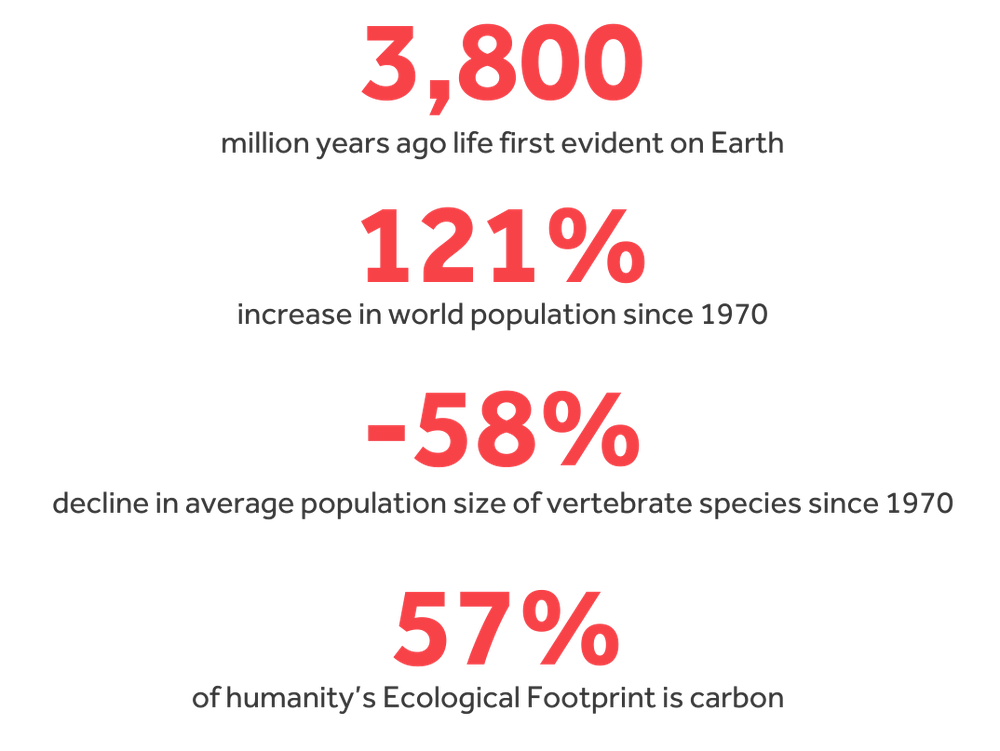Earth Overshoot Day - what is it and how can we #movethedate?

Earth Overshoot Day is the day that the Earth exceeds its consumption of the resources that it can regenerate - ‘A country’s overshoot day is the date on which Earth Overshoot Day would fall if all of humanity consumed like the people in this country’ [1].
This year for the UK it falls on 19th May. At that point in time we will have used all the resources that we can sustainably regenerate, nearly seven whole months before the end of the year.
I spent my first six month-placement as an Associate at an environmentally focused startup transitioning into a more established business. I worked on their Impact Report which led me to researching carbon measuring. When researching carbon footprinting I came across a number of debates as to whether ‘Net Zero’ is enough [2]. Whilst ‘Net Zero’ is a step in the right direction, it isn’t regenerating resources in a sustainable way, which as a result is not reducing emissions enough to pull back the UK’s Overshoot Day. On the whole it seems that businesses and individuals can feel overwhelmed by the options and the vocabulary used in this sphere when planning to become ‘Net Zero’ or ‘Carbon Negative’.
This prompted me to reflect on what I have learned in this area since joining On Purpose. The most important message from this reflection is ‘not letting perfect be the enemy of good’.
Earth Overshoot Day highlights the urgency of the climate crisis and the importance of the UK (and the rest of the World) getting to Net Zero. Net Zero would balance the emissions produced with the amount removed from the atmosphere. This process can seem daunting and unachievable, which is why I created this post.
Here are 30 tips I want to share from my research and suggestions that I would recommend to people embarking on their own Net Zero journey. I wanted to share these findings to help others, especially businesses, navigate the hurdles of Net Zero. This list is by no means exhaustive, but more a collaboration of my own findings over the past six months...
Investing
Investments are sought by businesses looking to start-up or grow. Investors will often have a portfolio of work/areas
1. ESG (Environmental, Social, Governance criteria) and Impact are lagging in private markets due to the risk factor and lack of integration - this needs to become a priority and a major consideration for longevity of investment
2. Only businesses with ESG firms are going to be investable as they have long term viability, so consider your ESG strategy.
Certifications
To benchmark high standards of social and environmental performance, ensuring accountability and improvements
3. With BCorp certification, start the process early when a business is small (you only need 1 year of revenue to begin the process).
4. Do not go too far down the line of action of changing/improving actions without tracking emissions - to get certification you need to show active improvements and a strategy.
Measuring Impact
Identifying and tracking the progress of your impact
5. Start the measuring process in the early days of a startup.
6. Use the first year as a light assessment (think scope 1 - direct emissions such as fuel [3]).
7. Think about scope 3 (all other emissions such as employee commuting, supplier emissions, supply chain [4]) as a broader thought and not get too overwhelmed.
8. Take action before detailed measurement to save you time.
9. Go for the low hanging fruit - start it early for the easy wins!
10. Supply chains are a longer process and a large proportion of the overall footprint. Focus on the largest part first and understand this is hard to control.
11. Look at your website, the carbon impact as well as the message it communicates (www.websitecarbon.com)
12. Use an external auditor for verification.
13. Look at your energy supplier and find one based on renewable sources.
14. It takes time, money and resources; be prepared!
15. Most people outsource measuring to experts, but it still needs someone internally to champion it.
16. Carbon accounting should align with financial accounting.
17. Use science based targets [5], aligning goals and emission reduction with scientific research that are aligned to the Paris Agreement [6].
18. Bring on suppliers with the same goals.
19. Don’t be afraid of calculations for a shared office space – you can do this pro rata based on headcount, energy use per employee or local emissions factor based on that area/country.
Offsetting and Carbon Removals
Carbon offsetting is a way of paying to cancel out your own emission whereas removals actively takes carbon out of the atmosphere
20. Invest in carbon removals early, carbon removals take carbon dioxide out of the atmosphere [7].
21. Have a portfolio of carbon removal methods rather than a single one (no single method will cover the deficit for 2050) - buying/planting trees, burying carbon, new technologies.
22. Offsetting is prone to bad accounting methods.
23. In a tech company it is roughly £100-£300* per employee per year to offset 2.5 tonnes* per employee as a benchmark in the workplace (unless you have measured your own).
24. Offsetting roughly costs £50* per tonne.
*These are current figures from conducting my own research. They are subject to change and interpretation but they give an idea of the amounts for offsetting.
Employee Engagement
Employee engagement is key to a company's strategy
25. Needs someone in the business to champion and take ownership - involve all employees, especially board level buy in!
26. Businesses need a full time employee with passion and consistency.
27. Embed sustainability in the organisation.
28. Embed ESG in company policies.
29. Incentivise sustainable travel.
30. Encourage behavioural change for employee emissions at home.
As we now have hit the UK’s Overshoot Day, it highlights that although Net Zero may not necessarily ‘be enough’, it is a small step in the right direction towards being carbon negative and only using the resources that can be regenerated or actively taking measures to offset or removal carbon in the atmosphere. This is an evolving space that comes under increasing scrutiny, however this cannot be a deterrent or excuse. Earth Overshoot Day brings the climate crisis into stark reality and that together individuals and businesses can make a change that is time critical. If actions, like those highlighted in the above list, are not taken into consideration and actioned upon then we would have thrown away our shot of changing the current Earth Overshoot Day. #MoveTheDate
Earth Overshoot Day By the Numbers

References
- https://www.overshootday.org/newsroom/country-overshoot-days
- https://www.gov.uk/government/speeches/more-than-zero-why-net-zero-alone-wont-save-the-planet-and-what-will; https://www.forbes.com/sites/feliciajackson/2021/08/30/net-zero-is-no-longer-enough--its-time-for-net-negative-policy-coherence-and-robust-esg/?sh=3bf968dd6a34
https://www.theguardian.com/environment/2020/nov/13/hitting-net-zero-is-not-enough-we-must-restore-the-climate - https://www.sustain.life/blog/scope-emissions
- https://www.carbontrust.com/resources/briefing-what-are-scope-3-emissions
- https://sciencebasedtargets.org
- https://unfccc.int/process-and-meetings/the-paris-agreement/the-paris-agreement
- https://www.ipcc.ch/2022/04/04/ipcc-ar6-wgiii-pressrelease/
